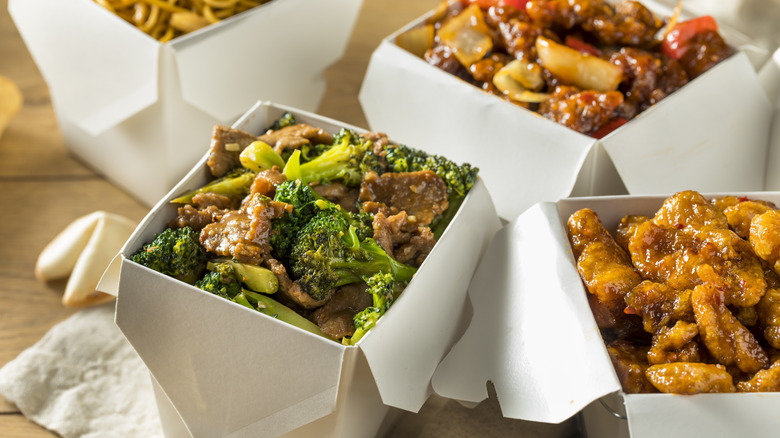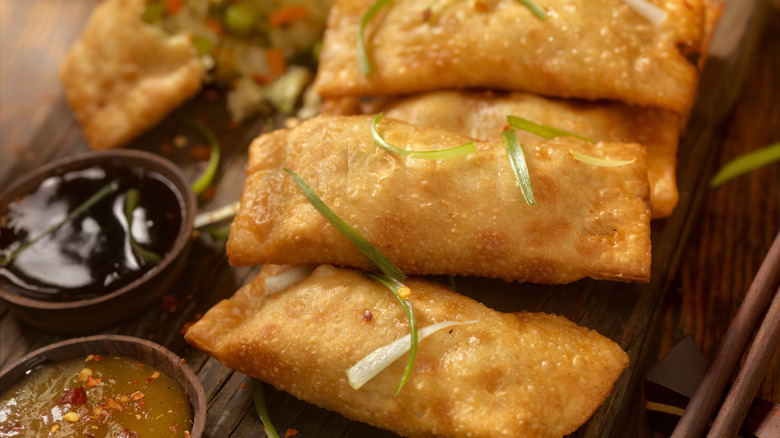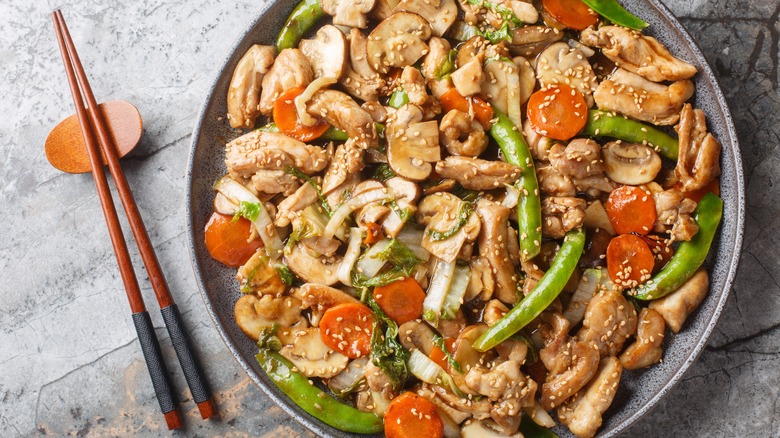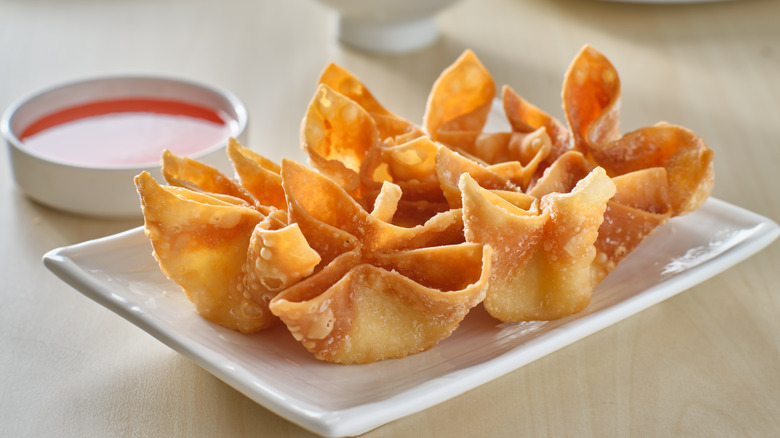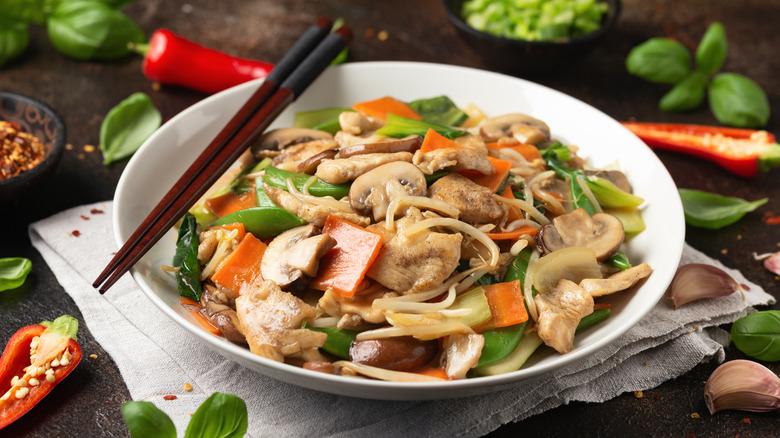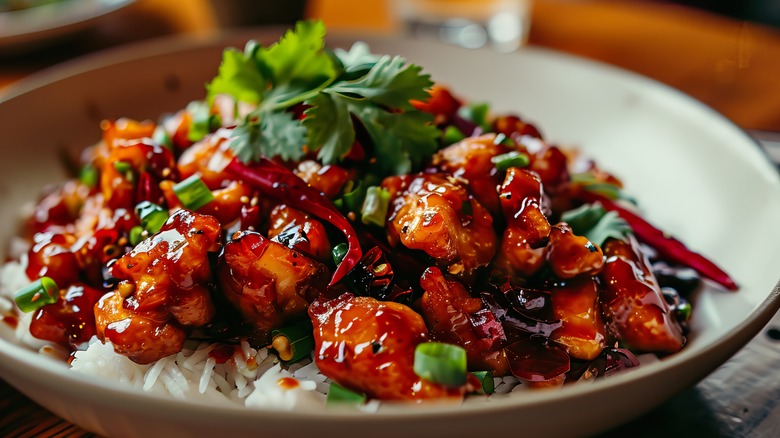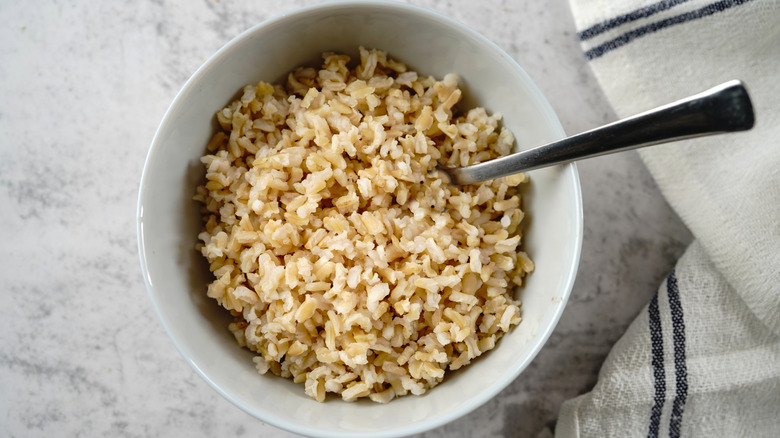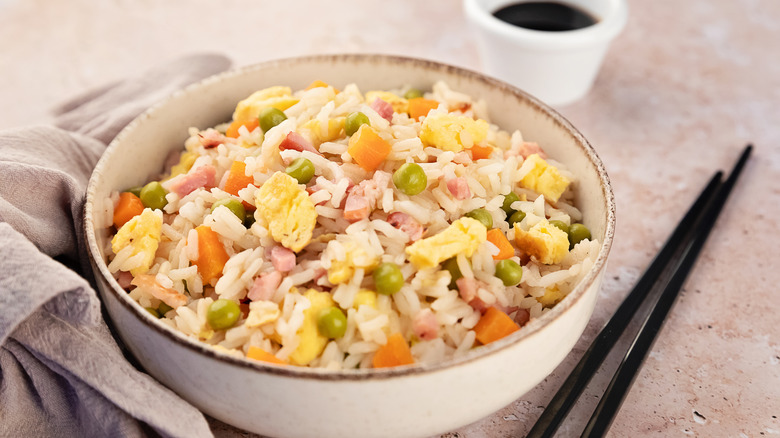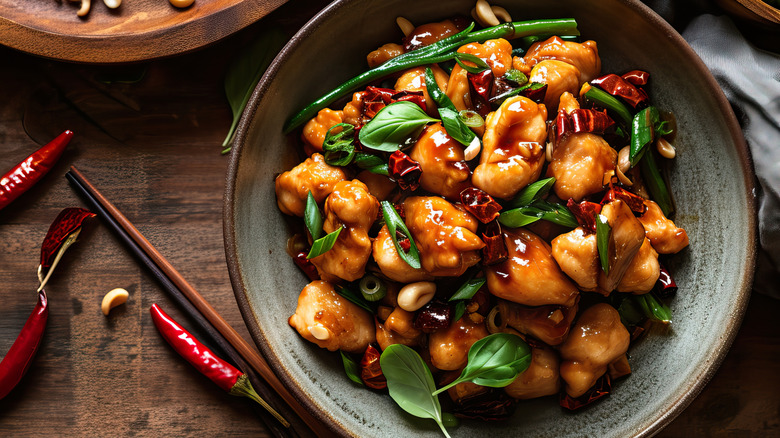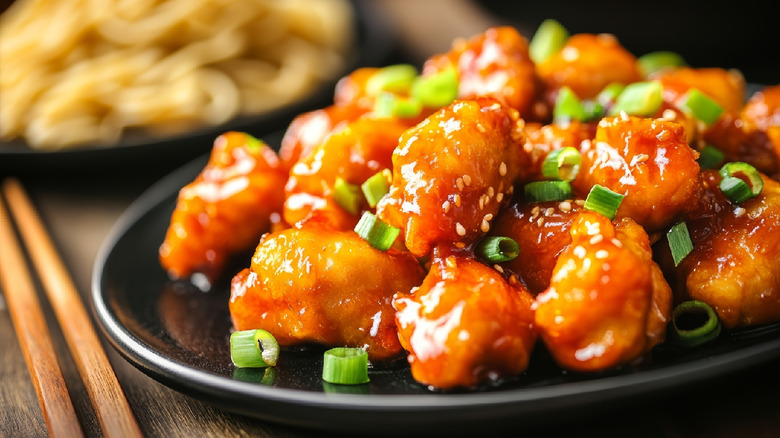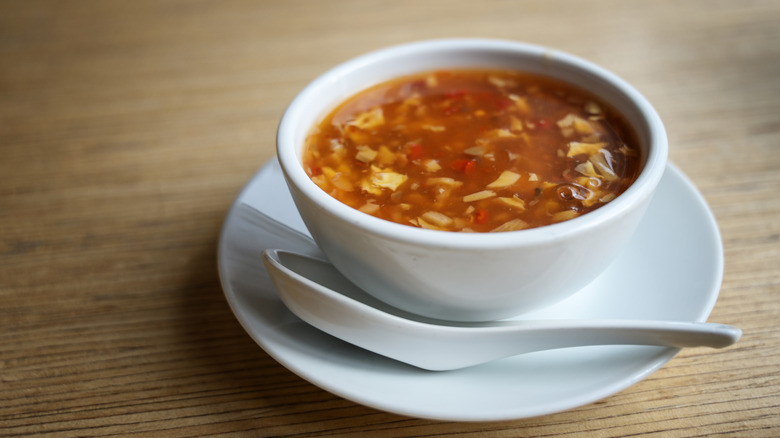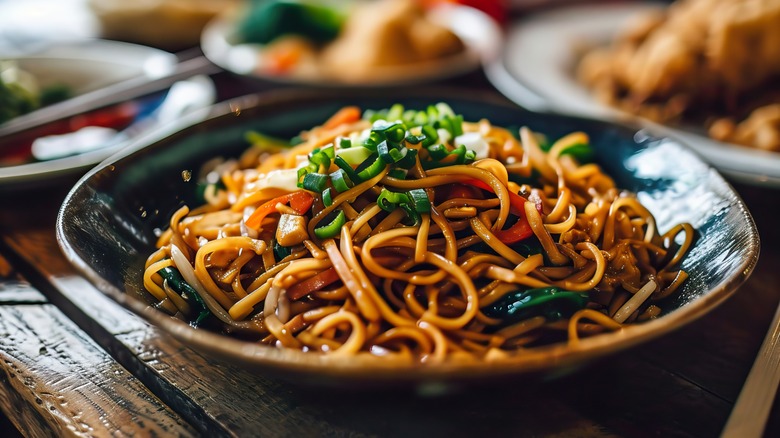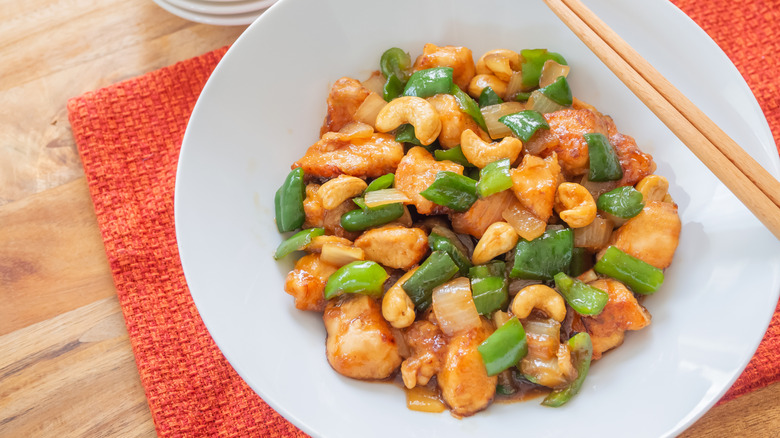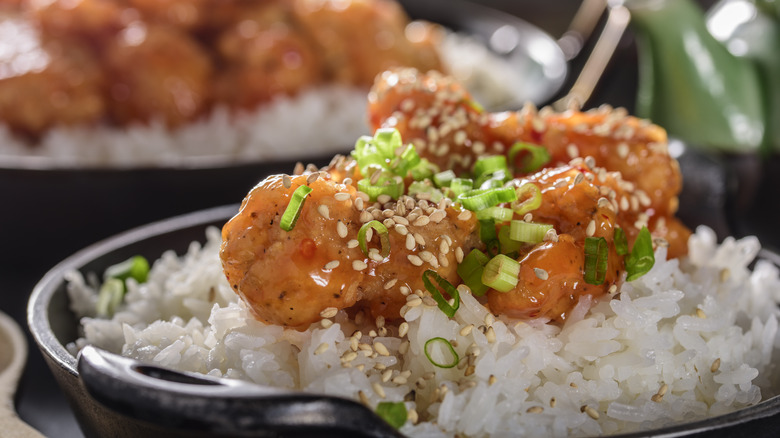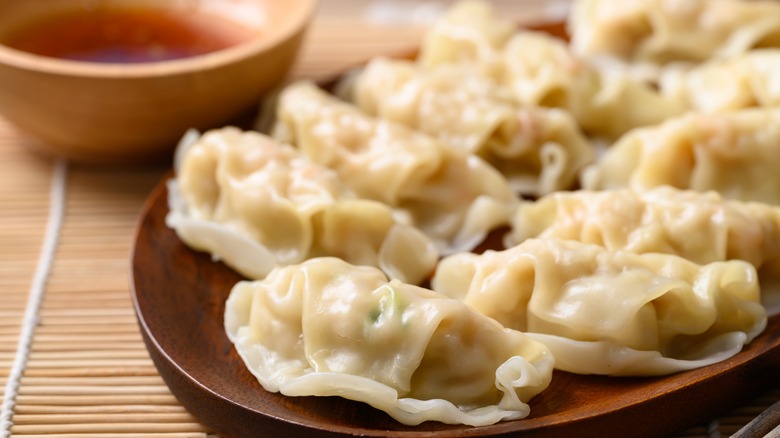7 Unhealthiest And 8 Healthiest Foods To Order At A Chinese Restaurant
Maybe you're DoorDash-ing your favorite Chinese takeout items from a revered local spot. Maybe you're stopping by the drive-thru at a national chain like Panda Express. Maybe you're even sitting down at a chain restaurant with a slightly more elevated atmosphere, such as P.F. Chang's, or at an upscale eatery like the Michelin-starred Wing Lei in Las Vegas. Whatever the case, there's something about Chinese food that consistently hits the spot.
So many of the cuisine's staple, savory, succulent, umami-packed dishes have become comfort foods for many diners. Plenty of diners have a go-to Chinese dish for when they're feeling under the weather (egg drop soup, anyone?), craving something easy that'll result in lots of leftovers, or — let's be honest — need help recovering from a night of shenanigans.
For all its deliciousness, Chinese takeout and chain foods do come packed with some less-than-desirable ingredients on occasion. Salty, sugary, or fatty fried foods can make it harder to stick to your health goals if consumed on a regular basis. But don't worry — there are plenty of healthful options on many menus, too. Here are some of the healthiest (and unhealthiest) dishes.
Healthiest: Chicken or beef and broccoli
Chicken or beef with broccoli offers plenty of nutritional benefits, making it a smart choice for those seeking a healthier option on a Chinese takeout menu. If you opt for chicken, you get a lean protein. The broccoli is filled with nutrients such as vitamin C, vitamin K, and fiber while also being low-calorie. Whether you prefer chicken or beef, the dish is typically prepared via stir-frying rather than deep-frying, which saves you both fat and calories.
For example, if you look at the beef with broccoli and chicken with broccoli menu items at P.F. Chang's, you'll discover that these options are some of the lowest-calorie entree items overall. The beef with broccoli comes with just 300 calories and 23 grams of protein, while the chicken with broccoli comes with 240 calories and 30 grams of protein. If you're watching your sodium, you'll want to opt for the chicken with broccoli rather than the beef with broccoli, though, as the former typically comes with far less sodium than its beef counterpart.
Unhealthiest: Egg rolls
As a general rule, if you're looking for a nutritional meal, you'll want to avoid deep-fried items when dining on Chinese-American fare. Unfortunately, egg rolls fall into this category. Not only do you get the extra fat from the deep-frying, but egg rolls also pack extra carbs from the dough wrapper, and extra sugar from the duck sauce that is often served alongside egg rolls. Not to mention, there's the fact that it's hard to stop at just the one egg roll. Once you have the first, you gotta eat the second, too.
At Midwest Asian fast food chain Leeann Chin, the egg rolls are one of the highest-calorie appetizers on the menu, at 210 calories per egg roll and 23 grams of carbohydrates per egg roll. Compare that to the chain's pot stickers, which only come with 50 calories per pot sticker and 6 grams of carbohydrates — along with only 64 milligrams of sodium compared to the 600 milligrams of sodium you'll find in each egg roll — and it's clear which one might align best with a healthy diet.
Healthiest: Moo goo gai pan
It may not be as much of a takeout staple as egg rolls, but familiarizing yourself with moo goo gai pan could prove beneficial to your health. Moo goo gai pan is a Cantonese dish containing a mixture of chicken, mushrooms, and vegetables such as water chestnuts, often served in a lighter, broth-based sauce.
You're more likely to find moo goo gai pan served at a locally owned Chinese restaurant than at a national or regional chain. It was previously offered at P.F. Chang's, where the dish contained both chicken and shrimp, but it is no longer on the chain's menu (although that hasn't stopped fans from putting together copycat recipes). You can expect an average serving to be relatively low in calories, fat, and sodium, while containing an impressive amount of protein. In short, it's a nutritional choice that can easily slot into a healthy day of dining.
Unhealthiest: Crab rangoon
Crab rangoons are a deep-fried, delicious treat that provides a mouth-watering mix of cream cheese and imitation crab tucked inside a wonton wrapper. Like egg rolls, crab rangoons are one of those Chinese-American appetizers that are endlessly snackable. They're so small and so tasty, so why not chow down on four or five (or more)?
The crab rangoons may often contain fewer calories or less sodium than some of the other appetizers on a Chinese restaurant's menu, but this food also packs in some less-than-desirable elements. For example, at Leeann Chin, the cream cheese puffs may be lighter in calories and sodium than all of the appetizers (except the pot stickers), but they also have the most saturated fat. At Pick Up Stix, the cream cheese wontons have the second-most cholesterol, the third-most sodium and carbohydrates, and by far the most saturated fat of all the appetizer options.
Healthiest: Chop suey
Like chicken and broccoli, beef and broccoli, and moo goo gai pan, chop suey brings lean protein and a variety of veggies to the table. Health-wise, there's a lot to love about this dish. It is stir-fried rather than deep-fried, and contains no noodles, though you may choose to enjoy it over brown rice. The protein may vary, but you often get to pick between chicken, pork, beef, or tofu. There are usually eggs involved, with veggies including cabbage, celery, or bean sprouts. However, the very essence of chop suey is that it uses up whatever's on hand, with its name more or less translating to "odds and ends."
Chop suey isn't as popular as it once was, so you may not find it as easily as the likes of, say, chicken and broccoli. However, a typical serving can include around 260 calories, 670 milligrams of sodium, 25 grams of protein, and a hefty portion of your daily required iron.
Unhealthiest: General Tso's chicken
General Tso's chicken is named for a very real general, having apparently been invented in the mid-20th century by a prestigious Hunanese chef. The original dish served in the chef's restaurant in Taipei may not be exactly what you'll get at your local Chinese restaurant, but it bears some resemblance. Today, we know General Tso's as a deep-fried chicken staple coated in a spicy-sweet sauce. Unfortunately, while this dish may be an American-Chinese classic, it's one you may want to avoid if you have certain health goals in mind.
At many restaurants, General Tso's chicken is not only high in calories, but also in fat and sodium. You can find slightly less salty and sugary versions of General Tso's sold in the frozen foods aisle of your local grocery store, but the outlook isn't much more positive. For example, a serving of Kahiki General Tso's Chicken comes with nearly 40% of your daily recommended sodium and almost a third of your daily recommended added sugar. Similarly, a serving of InnovAsian's General Tso's chicken likewise comes with nearly 40% of your daily recommended sodium and 34 grams of sugar. If you're having a difficult time imagining just how much sugar that is, consider that one teaspoon of sugar equals roughly 4 grams of sugar, so eating one serving of this frozen chicken is equivalent to eating about nine teaspoons of sugar.
Healthiest: Brown rice
Whatever you order for your entree when dining at a Chinese restaurant or ordering Chinese takeout, you'll likely be given a few rice options for your side. When weighing up whether you should get fried rice, white rice, or brown rice, opt for brown rice if you want to secure the greatest health benefits. Even the difference between white and brown rice is significant.
At Leeann Chin, the steamed brown rice contains 130 calories compared to the 150 calories in the white rice and 170 in the fried rice, and 3 grams of fiber compared to the 1 gram of fiber in the other two options. At Pick Up Stix, the steamed brown rice similarly contains fewer calories and carbohydrates than the white rice, while also offering more fiber. The story is exactly the same at P.F. Chang's. Not to mention, when you begin to look at the various nutrients that brown rice offers that aren't typically listed on a restaurant's nutrition page, you'll find even more good stuff, such as magnesium, potassium, iron, and B vitamins.
Unhealthiest: Fried rice
While steamed brown rice may be superior to white rice in most cases, white rice still has a leg up on the unhealthiest rice option on the menu: fried rice. Unfortunately, the frying process adds a lot of extra fat and salt to the dish.
At Leeann Chin, a serving of the fried rice contains a whopping 1,460 milligrams of sodium. That's more than double what you'd get in the chain's Asian noodles and a far cry from the 11 milligrams found in the brown rice and the 0 milligrams in the white rice. Meanwhile, at Pick Up Stix, the egg fried rice comes with 810 milligrams of sodium, compared to 5 milligrams in the restaurant's brown rice and 0 milligrams in the white rice. Pick Up Stix's egg fried rice also comes with 2 grams of saturated fat compared to the 0 grams in both the white and brown rice. The amount of sodium and saturated fat only increases when you add extra protein, such as beef or chicken.
Healthiest: Kung pao chicken
For a healthier alternative to General Tso's chicken, consider ordering kung pao chicken, which comes with spicy, stir-fried chicken (rather than deep-fried chicken), plus vegetables and peanuts, for a hefty dose of protein and nutrients such as niacin and selenium.
At P.F. Chang's, the steamed variety of kung pao chicken comes with 300 calories, 14 grams of fat, 950 milligrams of sodium, and 9 grams of sugar. While these aren't exactly stellar numbers (except for the low calories), they're definitely better than those attached to other chicken entrees at the restaurant. For example, the teriyaki chicken packs in 490 calories, 22 grams of fat, 1,150 milligrams of sodium, and an eye-watering 35 grams of sugar. Meanwhile, the sesame chicken comes with 490 calories, 24 grams of fat, 1,030 milligrams of sodium, and 24 grams of sugar. So, at P.F. Chang's at least, you could do a lot worse than the kung pao chicken.
Unhealthiest: Sweet and sour pork or chicken
Delicious though it may be, let's be honest: Sweet and sour chicken is basically just chicken nuggets with sauce. However, that's what makes it such a delicious takeout favorite for even the pickiest of eaters. The fact that the chicken — or the pork, if you prefer sweet and sour pork — is battered and fried, as well as the amount of sugar used to give the typical sweet and sour sauce its sweetness, makes this a dish you may want to eat in moderation.
While the sweet and sour chicken at P.F. Chang's is relatively low in calories and sodium, it also contains a lot more carbohydrates, sugar, and fat than many of the other entrees on the menu. At Leeann Chin, the facts are pretty much the same, with the sweet and sour chicken sitting in the middle of the pack in terms of entrees with a large amount of fat, carbs, and sugar (even if it is, again, relatively low in sodium). One thing you can do to make this dish a little more nutritionally balanced? Ask for the sauce on the side, or even no sauce at all.
Healthiest: Hot and sour soup
Flavorful and filled with healthful ingredients such as mushrooms and bamboo shoots, as well as often plant-based forms of protein like tofu, hot and sour soup offers a lot of benefits. If you order the hot and sour soup at P.F. Chang's, you'll find that it contains fewer calories than the chain's chicken noodle and wonton soups, less fat than the wonton soup, and some of the lowest amounts of sodium and sugar out of all the soup options.
Of course, as is often the case when dining out, your menu item of choice may be influenced by your individual health goals. For example, if you're at P.F. Chang's and your top priority is cutting down on carbs, the egg drop soup may be a better option. However, for the most part, the hot and sour soup is relatively balanced on the majority of nutritional fronts.
Unhealthiest: Chow mein
Whether you consume it as a side or a main, chow mein is another dish of which you may want to steer clear when ordering Chinese takeout. The carb-heavy noodles and fat from frying make chow mein one of the higher-calorie, higher-fat options on most menus.
At Pick Up Stix, the beef chow mein ranks sixth for calories on a menu of over 20 noodle and rice options. It also ranks high in terms of fat, carbohydrates, and sugar content. At Panda Express, the chow mein has the second-highest amount of sodium out of all the side options, as well as the third-highest amount of carbohydrates, and the highest amount of sugar.
Want a healthier alternative? Opt for lo mein over chow mein. While chow mein noodles are often fried, lo mein noodles are typically boiled, meaning they are often lower in both calories and sodium.
Healthiest: Cashew chicken
Another stir-fried chicken dish that provides a healthier alternative to the many breaded and deep-fried chicken dishes you'll find on Chinese menus, cashew chicken usually contains a few vegetables and cashews in a lighter sauce. The cashew chicken at Leeann Chin comes in third for the fewest calories out of all the entree options, following only the mixed vegetables entree and the stir-fried shrimp and vegetable entree. It also contains less fat than many other entrees, and comes in second place for the least carbs (following, again, the mixed vegetables). It also contains just 390 milligrams of sodium and only 3 grams of sugar per serving.
Pick Up Stix has a Thai basil cashew chicken option that's extremely similar, with the fourth-least calories per serving out of all the chicken entrees, and relatively little cholesterol, sodium, and sugar compared to your other options at the chain. The only other chicken entrees with fewer calories are the chicken and vegetables, garlic chicken, and teriyaki chicken, but these don't stack up quite as well on the cholesterol, carbs, sodium, and sugar fronts.
Unhealthiest: Orange chicken
Breaded, fried, and smothered in a fragrant, sweet sauce, you probably could've guessed that orange chicken would wind up among the least-healthy options you could order from a Chinese restaurant. Panda Express' orange chicken, which is often considered the pinnacle of junky Chinese-American takeout, has the most calories out of all the other entree options, as well as a significant amount of fat and sugar. It also contains a whopping 850 milligrams of sodium per serving, outdoing the majority of other entrees on the menu.
At Pick Up Stix, the data doesn't look all that different. The orange chicken ranks as one of the top five, highest-calorie items you could order off the chicken entree menu. The chain's orange chicken likewise ranks high for fat content, carbohydrates, and cholesterol. Meanwhile, it contains 26 grams of sugar, which is equal to about 6.5 teaspoons of sugar — and no one wants to just straight-up eat 6.5 teaspoons of sugar.
Healthiest: Steamed dumplings
In terms of health, steamed dumplings are always going to rank better than fried or crispy dumplings. Just consider the chicken dumplings at Pick Up Stix. The steamed version of the dumplings contains less than half the calories found in the crispy dumplings. When comparing the steamed dumplings to the other appetizer options at the chain, you'll find that they have fewer carbs than many of your other options, and that they're also tied with the edamame and the vegetable spring rolls as the lowest-fat appetizer.
Compare the shrimp dumplings at P.F. Chang's – which likewise come either steamed or pan-fried — and you'll find something similar. The steamed dumplings have fewer calories and less fat than their pan-fried counterparts. When you look at the appetizer options overall, a serving of six shrimp steamed dumplings contains 50 calories, 1 gram of fat, and 270 milligrams of sodium, making them the lowest-calorie and lowest-fat option.
